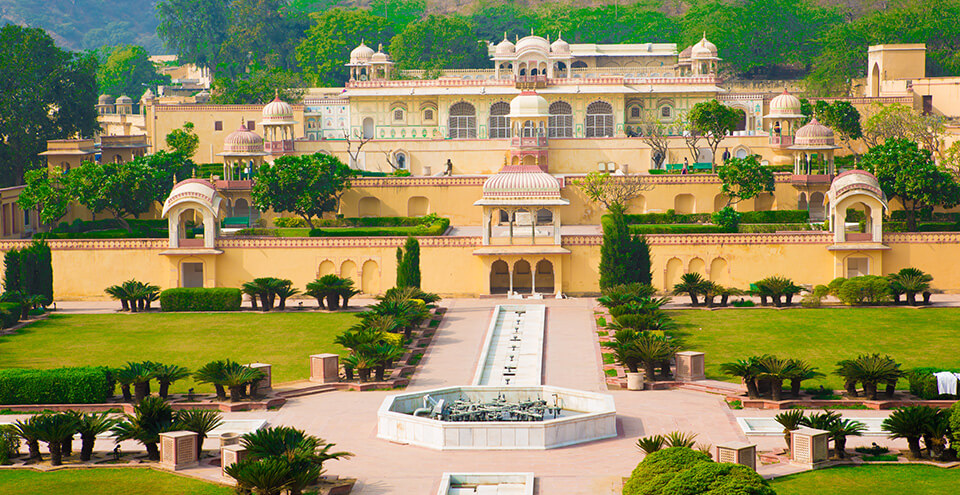
Sisodia Rani Palace and Garden: A Regal Oasis
Perched on the outskirts of Jaipur, the Sisodia Rani Palace and Garden is a breathtaking example of Rajput architecture and horticultural artistry. Built in the late 17th century, this enchanting palace and its lush gardens were designed as a retreat for Queen Sisodia, the wife of Maharaja Sawai Jai Singh II, the founder of Jaipur. It stands as a testament to the grandeur of Rajputana architecture and the sophistication of Mughal garden design.
Historical Background
Constructed in 1728, Sisodia Rani Palace and Garden were commissioned by Maharaja Sawai Jai Singh II for his beloved queen, Sisodia. The palace was designed to provide a serene escape from the bustling city of Jaipur, offering the queen a tranquil retreat with picturesque surroundings. The architectural and garden design reflects the blend of Rajput and Mughal influences prevalent during that era.
Architectural and Garden Features
1. Architectural Elegance
Regal Design: The Sisodia Rani Palace is characterized by its elegant Rajput architecture, featuring multi-storied structures, ornate arches, and intricate frescoes. The palace’s design reflects a harmonious blend of traditional Rajput and Mughal styles.
Beautifully Decorated Interiors: The interiors of the palace are adorned with vibrant frescoes depicting scenes from Hindu mythology, including images of Lord Krishna and his divine consort Radha. The frescoes are noted for their rich colors and intricate detailing, adding to the palace’s regal charm.
Charming Pavilions: The palace includes several pavilions and balconies that offer stunning views of the surrounding gardens and landscape. These spaces were designed for relaxation and enjoyment, allowing the queen to immerse herself in the natural beauty of the area.
2. Lush Gardens
Terraced Layout: The gardens of Sisodia Rani Palace are laid out in a terraced manner, with each level offering a unique perspective of the landscape. The terraced design creates a visual flow and allows for a diverse array of plantings.
Fountains and Water Features: The gardens are adorned with elaborate fountains, water channels, and pools that add to the serene ambiance. The sound of flowing water enhances the peaceful atmosphere, making the gardens a perfect retreat for relaxation.
Floral and Vegetative Diversity: The gardens boast a rich variety of flowering plants, shrubs, and trees, including seasonal blooms that add color and fragrance to the environment. The careful planning and maintenance of the gardens reflect the sophistication of Mughal garden design.
Symbolic Design: The garden layout often incorporates symbolic elements, such as geometric patterns and lotus motifs, which are common in Mughal and Rajput garden design. These elements add a layer of cultural significance and aesthetic appeal.
Cultural and Historical Significance
Sisodia Rani Palace and Garden are significant not only for their architectural beauty but also for their cultural and historical value. The palace and gardens embody the royal taste and sophistication of the Rajput era and reflect the cultural exchange between Rajput and Mughal traditions.
The frescoes and design elements of the palace offer insights into the artistic and religious themes of the time, while the gardens showcase the grandeur of Mughal horticultural practices. Together, they provide a comprehensive view of the opulent lifestyle of the Rajput royalty and their appreciation for art and nature.
Visiting Sisodia Rani Palace and Garden
Sisodia Rani Palace and Garden are located about 10 kilometers from Jaipur, making them easily accessible for visitors exploring the city and its surroundings. The best time to visit is from October to March when the weather is cooler and more comfortable for outdoor activities.
Here are some tips for your visit:
Guided Tours: To fully appreciate the history, architecture, and design of Sisodia Rani Palace and Garden, consider joining a guided tour. Guides can provide valuable information about the palace’s significance, the artistic details, and the garden’s design.
Photography: The palace’s interiors and gardens offer excellent photography opportunities. Capture the intricate frescoes, elegant architecture, and vibrant garden landscapes. Be respectful of any restrictions on photography, especially in certain areas.
Dress Comfortably: Wear comfortable clothing and footwear, as you will be exploring both the palace and the gardens. The gardens involve walking on uneven surfaces, so appropriate footwear is essential.
Explore Jaipur: While visiting Sisodia Rani Palace and Garden, take the opportunity to explore other notable attractions in Jaipur, such as the Amer Fort, City Palace, and Hawa Mahal. These sites complement your visit and offer a broader understanding of Jaipur’s royal heritage.
Experience Royal Serenity
Sisodia Rani Palace and Garden offer a captivating glimpse into the elegance and grandeur of Rajput architecture and Mughal garden design. The combination of regal architecture and lush gardens creates a serene and picturesque retreat that embodies the opulence of Rajasthan’s royal past.
When in Jaipur, make sure to include Sisodia Rani Palace and Garden in your itinerary. Experience the beauty of this regal oasis and immerse yourself in the tranquility and artistic splendor of one of Rajasthan’s most enchanting destinations.
Explore the exquisite charm of Sisodia Rani Palace and Garden, where regal elegance and horticultural artistry converge to create a memorable experience. Let the historical splendor and natural beauty of this magnificent site enhance your journey through Rajasthan.
